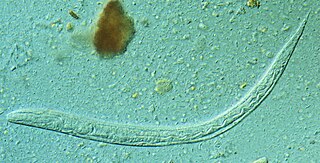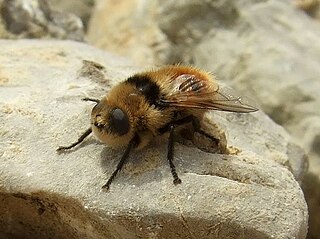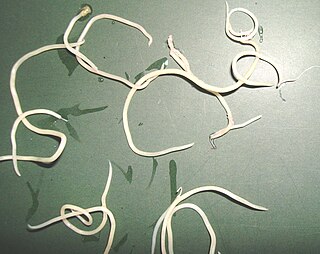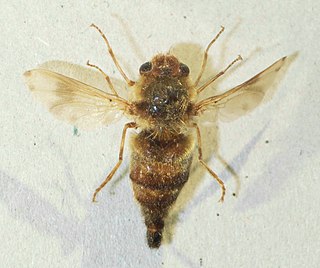
Strongyloides stercoralis is a human pathogenic parasitic roundworm causing the disease strongyloidiasis. Its common name in the US is threadworm. In the UK and Australia, however, the term threadworm can also refer to nematodes of the genus Enterobius, otherwise known as pinworms.

Trichuriasis, also known as whipworm infection, is an infection by the parasitic worm Trichuris trichiura (whipworm). If infection is only with a few worms, there are often no symptoms. In those who are infected with many worms, there may be abdominal pain, tiredness and diarrhea. The diarrhea sometimes contains blood. Infections in children may cause poor intellectual and physical development. Low red blood cell levels may occur due to loss of blood.

Botflies, also known as warble flies, heel flies, and gadflies, are a family of flies technically known as the Oestridae. Their larvae are internal parasites of mammals, some species growing in the host's flesh and others within the gut. Dermatobia hominis is the only species of botfly known to parasitize humans routinely, though other species of flies cause myiasis in humans.

The Gasterophilus, commonly known as botfly, is a parasitic fly from the family Oestridae that affects different types of animals, especially horses, but it can also act on cows, sheep, goats and, even, it has been recorded a case in a human baby.

Myiasis is the parasitic infestation of the body of a live animal by fly larvae (maggots) which grow inside the host while feeding on its tissue. Although flies are most commonly attracted to open wounds and urine- or feces-soaked fur, some species can create an infestation even on unbroken skin and have been known to use moist soil and non-myiatic flies as vector agents for their parasitic larvae.
Gnathostomiasis is the human infection caused by the nematode (roundworm) Gnathostoma spinigerum and/or Gnathostoma hispidum, which infects vertebrates.

Ascaridia galli is a parasitic roundworm belonging to the phylum Nematoda. Nematodes of the genus Ascaridia are essentially intestinal parasites of birds. A. galli is the most prevalent and pathogenic species, especially in domestic fowl, Gallus domesticus. It causes ascaridiasis, a disease of poultry due to heavy worm infection, particularly in chickens and turkeys. It inhabits the small intestine, and can be occasionally seen in commercial eggs.

Dictyocaulus is a genus of nematode parasites of the bronchial tree of horses, sheep, goats, deer, and cattle. Dictyocaulus arnfieldi is the lungworm of horses, and Dictyocaulus viviparus is the lungworm affecting ruminants.
Gnathostoma spinigerum is a parasitic nematode that causes gnathostomiasis in humans, also known as its clinical manifestations are creeping eruption, larva migrans, Yangtze edema, Choko-Fuschu Tua chid and wandering swelling. Gnathostomiasis in animals can be serious, and even fatal. The first described case of gnathostomiasis was in a young tiger that died in the London Zoo in 1835. The larval nematode is acquired by eating raw or undercooked fish and meat.

Strongylus vulgaris, commonly known as the blood worm, is a common horse parasite in the phylum Nematoda. It looks like a long worm with a large biting mouth. They are usually reddish in color because of all the blood they take from the equine host. This nematode is considered to be one of the "most pathogenic" of the large strongyles subphylum and is distributed worldwide, wherever there are grassland and temperate environments.

Cordylobia anthropophaga, the mango fly, tumbu fly, tumba fly, putzi fly, or skin maggot fly, is a species of blow-fly common in East and Central Africa. It is a parasite of large mammals during its larval stage. C. anthropophaga has been endemic in the subtropics of Africa for more than 135 years and is a common cause of myiasis in humans in the region.
Lungworms are parasitic nematode worms of the order Strongylida that infest the lungs of vertebrates. The name is used for a variety of different groups of nematodes, some of which also have other common names; what they have in common is that they migrate to their hosts' lungs or respiratory tracts, and cause bronchitis or pneumonia. The lungworm will gradually damage the airways or lung tissue by inciting an inflammatory reaction inside the tissue. Ultimately, the parasites survive and reproduce in the respiratory tissues. The category is thus more a descriptive than a precisely taxonomic one.

The microfilaria is an early stage in the life cycle of certain parasitic nematodes in the family Onchocercidae. In these species, the adults live in a tissue or the circulatory system of vertebrates. They release microfilariae into the bloodstream of the vertebrate host. The microfilariae are taken up by blood-feeding arthropod vectors. In the intermediate host the microfilariae develop into infective larvae that can be transmitted to a new vertebrate host.

Thelaziasis is the term for infestation with parasitic nematodes of the genus Thelazia. The adults of all Thelazia species discovered so far inhabit the eyes and associated tissues of various mammal and bird hosts, including humans. Thelazia nematodes are often referred to as "eyeworms".
Gnathostoma hispidum is a nematode (roundworm) that infects many vertebrate animals including humans. Infection of Gnathostoma hispidum, like many species of Gnathostoma causes the disease gnathostomiasis due to the migration of immature worms in the tissues.

Anoplocephala perfoliata is the most common intestinal tapeworm of horses, and an agent responsible for some cases of equine colic.

Many species of flies of the two-winged type, Order Diptera, such as mosquitoes, horse-flies, blow-flies and warble-flies, cause direct parasitic disease to domestic animals, and transmit organisms that cause diseases. These infestations and infections cause distress to companion animals, and in livestock industry the financial costs of these diseases are high. These problems occur wherever domestic animals are reared. This article provides an overview of parasitic flies from a veterinary perspective, with emphasis on the disease-causing relationships between these flies and their host animals. The article is organized following the taxonomic hierarchy of these flies in the phylum Arthropoda, order Insecta. Families and genera of dipteran flies are emphasized rather than many individual species. Disease caused by the feeding activity of the flies is described here under parasitic disease. Disease caused by small pathogenic organisms that pass from the flies to domestic animals is described here under transmitted organisms; prominent examples are provided from the many species.

Gasterophilus nasalis is a species of the genus Gasterophilus and family Oestridae. This species is found worldwide, but prominently present within the summer months. This species of G. nasalis primarily targets equines, such as horses, donkeys and the plains zebra. However, it's known that it targets cattle as well, along with mild cases of companion animals.

Gasterophilus intestinalis, also known as horse bot fly, is a species of insect of the family Oestridae, and is found worldwide. The adults, which have a bumblebee-like appearance, are prominently active in the summer. G. intestinalis is primarily a parasite of horses, mules and donkeys.
Parascaris univalens is a parasitic ascaridoid nematode that infects the gastrointestinal tracts of equines.
















